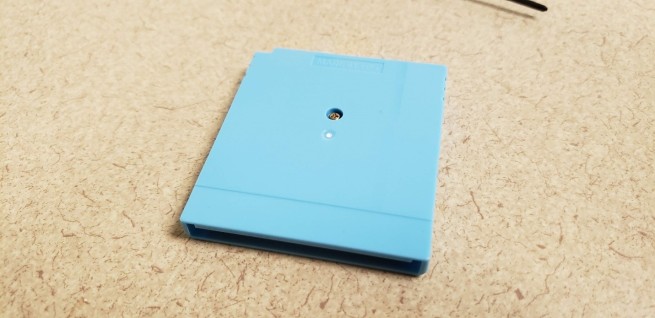Below is a short paper I wrote for an art history class assignment. Enjoy!
Tobu Tobu Girl was originally developed during the third GBJam[1] in 2016[2]. This prototype was then revised, expanded upon, until a completed version was released on December 3, 2017[3]. As a homebrew game, it was developed by a small, independent team (based in Denmark, Tangram Games), and not licensed by Nintendo, the hardware manufacturer for the Game Boy console. While Tobu Tobu Girl was an open-sourced game—free to download—it was still only the software that was available, or the ROM file that could be emulated on other devices, instead of played natively on the original hardware. As the Game Boy platform was also 28 years old[4] at the release of Tobu Tobu Girl, it was not likely to receive critical acclaim and could be seen more as a passion project. However, less than two years later on April 4, 2019, a Kickstarter campaign was launched in conjunction with First Press Games, to bring a remaster of the game to physical cartridges[5]. This Kickstarter campaign was a success—and how I received my copy—with the remaster being released on October 28, 2019[6]. The limited edition (of which I own) cost €64 plus shipping.
As a physical, technology device, it is composed of a variety of components and elements, including (but not limited to): plastic, silicon, a small lithium battery, and other rare earth metals[7]. The components alone could merit an essay, but I’ll attempt to briefly describe them here. Discarded, used electrical and electronic devices, known as “e-waste” is harmful to the environment—as noted by the United Nations—due to the toxic substances they are made out of, such as mercury, cadmium, and lead, which seep out.[8] E-waste is a globalized business, with about 70-80% of it shipped to landfills in developing nations where it is sorted and sold for scrap metal, or burned to extract materials.[9] A lack of regulation makes the e-waste industry especially dangerous, as there are few laws to protect marginalized groups and ensure their safety and the proper recycling of these hazardous and toxic products.[10] While the production and disposal of tech products is not heavily regulated and harmful to the environment, consumer attitudes or awareness about it is minimal, leading to some grass roots efforts to discuss the problems.[11]
As a physical object, its origins are varied and dependent upon the global supply chain, of which I can only speculate. However, as a cultural object the software is much easier to determine its origins. As mentioned earlier, there are two parties involved in the creation of this product, Tobu Tobu Girl Deluxe. The developers, Simon Jonas Larsen and Lukas Erritsø Hansen, are Danish video game designers who are active in the game development community, as evidenced by their participation in GBJam. While the Nordic countries are not among the primary centers of video game development—as major studios are typically found in North America or Eastern Asia—there has been a recent surge in government-funding to study video games as well as subsidies to encourage the industry to grow (Citation). The second party involved in the creation of this object was the producer, First Press Games, which is headquartered in Japan. This relationship, between the development studio of Tangram Games and the production studio of First Press, is common in media industries such as film and television which often require multiple businesses to ensure that the creative product is delivered to its intended audience. Tangram Games were able to write the code and produce the original software, but with First Press Games—and especially the Kickstarter campaign—came the funding and expertise to remake the game by adding color graphics, while also producing and selling physical cartridges of the game.
However, there are signifiers of the influence that Japanese culture has had on the software product, the game itself. The word tobu (とぶ) in Japanese is a verb meaning to jump, leap, spring, bound, hop, fly, or soar. The box art and the accompanying art direction for the game relies heavily upon anime-styling, calling to early Japanese video games that were developed for the Game Boy. The pastel watercolors, the large eyes, and the cartoonish proportions might come from the source material, but the end product feels timeless. As this product is meant to draw upon the nostalgia of consumers for Game Boy games, it also conveys a modern feel and artistic quality. It is neither an artifact of the past, or the present, but a blend of the two.
While this object has not directly influenced history, it is heavily influenced by it. As mentioned previously, this product is a cultural artifact of video game nostalgia. It is a homebrew game, meaning it was designed unofficially to work with traditional hardware and software. It was designed based upon the history of video games, with the designers learning from the mistakes and successes of previous games. And yet, while it is meant to feel like an older game, its success likely paves the way for more and more homebrew games to be developed for older game systems, influencing a new wave of video game developers. These designers grew up playing video games, and are now trying to recreate that feeling and atmosphere by designing for older hardware and older software, and releasing new games. There are many successful Kickstarter Campaigns similar to Tobu Tobu Girl Deluxe, some of which I have contributed to. These games are defining the history of the medium, by revealing a preoccupation with the past instead of a predominance for the future. While in terms of art and style, timeless design comes and goes in and out of fashion, technology is typically obsessed with capturing the now and the forthcoming. Devices and tools may become obsolete in years, taking with them the creative industries that support and rely upon them. While few are recreating the ecosystems of these older video game generations—including their parent companies, who are only focused on the business of now—games like Tobu Tobu Girl Deluxe are evidence of an interesting subculture.
[1] The GBJam is a “game jam,” or an event where game designers and developers are given a project or theme, and then create a game from scratch within a short period of time (in the instance of GBJam, it is to create a playable game for the Game Boy system).
[2] TangramGames
[3] TangramGames
[4] Wikipedia
[5] Kickstarter
[6] TangramGames
[7] For this assignment I actually took the cartridge apart and documented its internals, see the Appendix.
[8] Bidwell
[9] Gilpin
[10] Gilpin
[11] Brown
Bibliography
Tangram Games. Press release. Accessed on February 7, 2020. Retrieved from: https://tangramgames.dk/tobutobugirldx/press/
Kickstarter Campaign. Accessed on February 7, 2020. Retrieved from: https://www.kickstarter.com/projects/firstpressgames/tobu-tobu-girl-deluxe-for-gb-gbc
Wikipedia. Accessed on February 7, 2020. Retrieved from: https://en.wikipedia.org/wiki/Game_Boy
Lyndsey Gilpin. June 11, 2014. Tech Republic. “The depressing truth about e-waste: 10 things to know.” Accessed February 12, 2020. Retrieved from: https://www.techrepublic.com/article/the-depressing-truth-about-e-waste-10-things-to-know/
Allie Bidwell. December 16, 2013. US News. “U.N. seeks to solve growing global e-waste problem.” Accessed February 12, 2020. Retrieved from: https://www.usnews.com/news/articles/2013/12/16/un-seeks-to-solve-growing-global-e-waste-problem
Mark Brown. September 14, 2011. Wired. “Apple bans Phone Story game that exposes seedy side of smartphone creation.” Accessed February 13, 2020. Retrieved from: https://www.wired.com/2011/09/phone-story/
Appendix

Figure 1: The front of the cartridge; this is the “Western” limited edition of the game, the “Japanese” edition is pink with matching pink box art.

Figure 2: The rear of the cartridge; at the top reads “Made by FPG.”

Figure 3: The interior of the cartridge; components from NEC in Japan, Altera in America, Fujitsu in Japan, and Texas Instruments in America.
